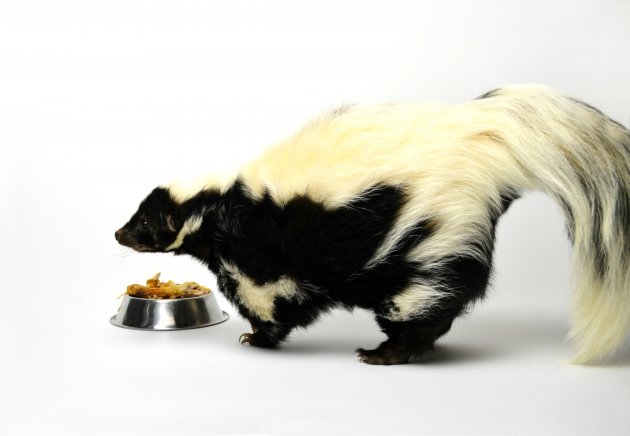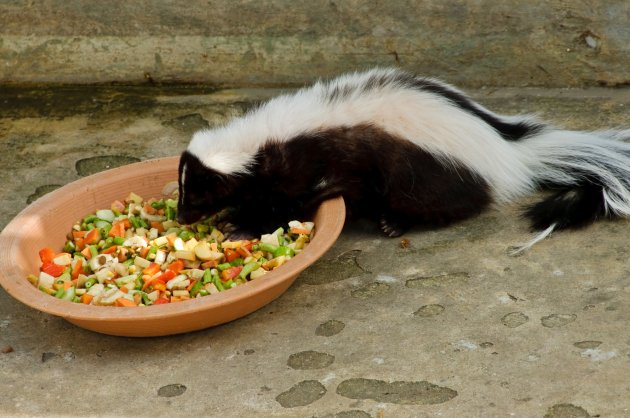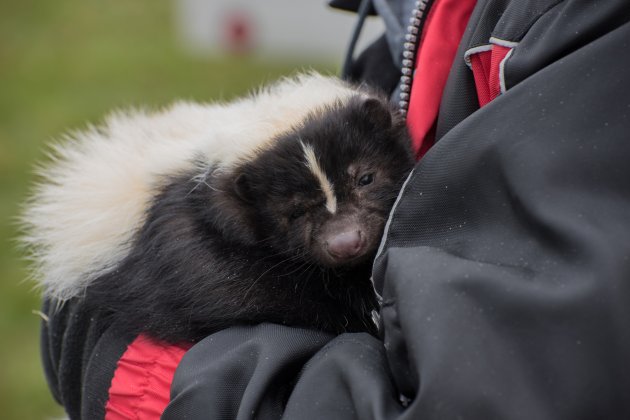When did the stinky skunk go from night time pest to pet? Although no one may ever know for sure when the skunk was first brought into a home and kept as a furry companion, we do know that in April of 2007, the Daily Mail reported that the skunk was increasing in popularity as a beloved pet.
If you think this animal is the right one for you, read on for some important tips on the skunk as a pet.

The Appearance of the Skunk
Everyone probably knows what a skunk looks like - black body, two white stripes running down its back and a plumed tail. It has well-muscled legs ending in small paws with long claws on the front feet (designed for digging).
The head of the skunk has a well-defined muzzle, small, rounded ears, a black nose and dark round eyes. Most species also have a predominant white stripe running down the middle of its face and muzzle.
Skunk Fast Facts
- Weight: 1 to 14 pounds (depending on the species)
- Length: 15 to 35 inches
- Lifespan: 7 to 10 years
- Native: North & South America
The Behavior of the Skunk
The most iconic trait of the skunk is, of course, its ability to spray its perceived threat with an obnoxious smelly, oily substance. Their spray is located in a gland under the tail, which can shoot up to 10 feet in distance. Although the spray is not harmful, the lingering odor can last for days and is very difficult to get rid of once it has permeated a person, animal, or surface.
Skunks are not aggressive by nature and will not go looking for an altercation (hence the defensive tactic of the spray). This species of animal is nocturnal and is, therefore, more active at night.
As a pet, the skunk can be headstrong and stubborn, but also very friendly, loving, playful, and entertaining. They are an active animal with a propensity to steal objects they deem worthy (usually those things that they feel will make their bed comfier).

Housing the Skunk
Skunks will not do well in a cage for long periods, therefore you will need to be prepared to allow your skunk to roam inside your home, with a large dog kennel as a safe spot or a place to keep your skunk when you are not able to supervise it. Outdoors, you will need a safe enclosure measuring at least six feet long, six feet wide, and three feet high with a nest box attached.
Both your home and the outdoor enclosure will need to be skunk-proof because if your pet gets loose, it can wander many miles away from home, with no natural “homing” abilities to get back to you.
Feeding & Caring For a Skunk
In the wild, skunks are considered omnivores, which means they eat whatever they can find. In your home, you will want to feed your skunk prepared skunk food. Avoid cat food as it is too high in fat for the skunk’s metabolism.
If you cannot find a prepackaged skunk diet, you can also feed your “lil stinker” a diet of 60 to 70% lean protein (cooked chicken, eggs, insects, or fish). The remaining part of the skunk’s diet should consist of fresh, cooked or thawed frozen vegetables.
You can also offer your skunk small bits of dog food, yogurt, cooked grains, and nuts and the occasional piece of fruit.
Foods high in calcium and taurine are also essential for your pet skunk or offer it in a supplement form.
Although skunks don’t drink a lot of water (most comes from food), you will want to make fresh water available to your pet at all times.
To have a skunk as a pet, you will also have to have its scent-sac removed and have your pet spayed or neutered. Find a vet that can perform these delicate procedures.

Handling a Skunk
Always handle your pet skunk with care and love. Never play aggressively with a baby skunk as they will continue the aggressive behavior into adulthood. It is recommended to use gloves or a stuffed toy when playing with a pet skunk due to their sharp front claws - these can produce a painful scratch.
Do not yell at or slap your skunk as this can create fear and mistrust.
Fun Skunk Facts
Want to learn more about this exotic pet? Check out these fun skunk facts!
- Skunks are highly intelligent
- This animal will roll caterpillars in the dirt to remove their hairs before eating it - the hairs are very irritating.
- Some skunks have spots instead of stripes
- In the wild, skunks live under logs, tree stumps, and in dens. Sometimes they will crawl into people’s attics or basements, too!
- There are 10 species of skunk
- Skunks can be brown, grey, or even the rare cream-colored.
- This animal has great hearing and smell, but poor vision.
- They are solitary animals.
- Skunks are one of the primary hunters of the honeybee
- This animal can only run 10 mph.
- Before a skunk sprays, it will stamp its front feet and growl. If the threat does not retreat, the skunk raises its tail and aims at the person or animal’s eyes.
- Baby skunks are called “kits.”
The Skunk & You
If you think a skunk would make a good pet for you, be sure to check with your city’s bylaws - some areas have made it illegal to keep a skunk as a pet.

Never take a skunk out of the wild as this is very traumatizing to the animal which can cause illness and even death.
Before you bring a skunk home, do your research into reputable breeders, then be sure to make all the necessary arrangements needed (enclosure, skunk proofing your home, outdoor enclosure, etc,).
Having an exotic pet is not the same as having a dog, cat, or bird. Do your homework, so you will be fully prepared to give your pet skunk the best life possible.
Further reading:
- UC IPM. Skunks Management Guidelines
- Skunk (Animal) by Alyce Miller ( 2016)
- Skunks (The World of Mammals) by Sophie Lockwood (2014)